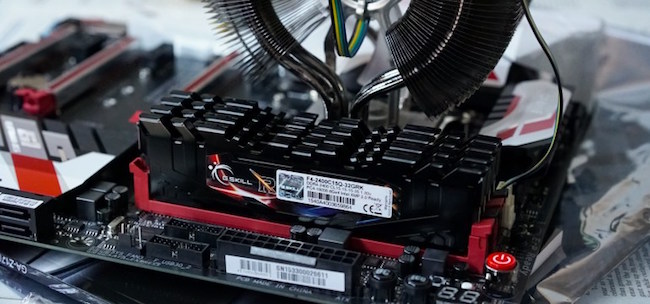
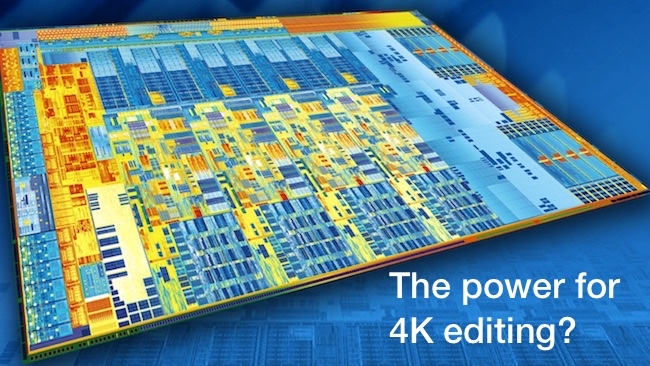 Editing in 4K? You might need one of these...
Editing in 4K? You might need one of these...
Replay: Can you buy a complete computer system off-the-shelf (or online) that keeps up with modern 4K video editing requirements? H. Paul Moon reckons you can.
This is a republished version of H. Paul Moon's original piece which you can read, along with many other excellent articles, here.
Filmmakers are a niche market to computer manufacturers, even where there’s crossover with gamers. So, they don’t design systems that target the unique demands of video editors. What are these demands, and for each, what is the current state-of-the-art?
1 Fast central processing unit (CPU) with overclocking: Intel Skylake
2 Fast storage drives: Solid State Disk (SSD)
3 Dedicated graphics processing unit (GPU) card: Nvidia GTX 900-series
4 Large, fast DRAM memory: DDR4
5 Expansible operating system (OS): Windows 10
That last item on the list is ammunition for warfare, pitting nerds against hipsters, so if you’re in the Church of Jobs anyway, read no further. This case study simply focuses upon building a Windows system, and my choice isn’t about loyalty or style: just getting maximum power. Laptops are totally out of the game: their portability isn’t worth it.
But setting aside an OS war, our first fork in the road is choosing the CPU, and there are basically two kinds, in the whole world of computers we’d use: AMD and Intel. For reasons and arguments not worth fleshing out, it’s best just to say that they are always neck-and-neck, but Intel always edges out AMD. Famously upgrading their CPUs within a “tick-tock” time frame, Intel recently launched their Skylake CPUs (the “tock” of a bigger boost in their product line), numbered in the 6000s. I went with the Core i7-6700K, which is a middle ground between their current fastest and slowest CPUs, while that “K” suffix means the chip is unlocked, allowing “overclocking” which we’ll get to soon.
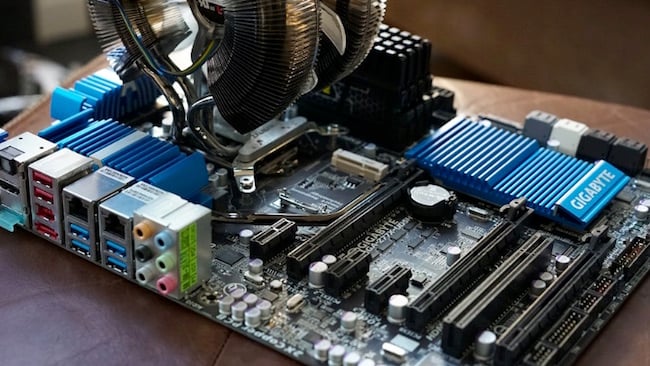
Above is a picture of the motherboard I stripped clean, before upgrading. One of the great things about building your own system is, you don’t need to throw everything away. Blu-ray drives and hard disks and fans and cases remain as compatible as ever. Re-using them is frugal and environmentally friendly!
From Ivy Bridge to Skylake
With my system, I had skipped a tick and tock, upgrading the last time to Intel Ivy Bridge with a Core i7-3770K, using that Gigabyte Z77-series motherboard you see above. After Haswell and Broadwell, now Intel’s Skylake architecture uses the Z170 motherboard line, and sticking with Gigabyte (who served me well, and who feature so-called “Ultra-Durable” components), I went with their GA-Z170X-GAMING7 motherboard. That “Gaming” suffix points to a theme: it’s because of gamers, who have little to do with creating cinematic arts, that technology has advanced so rapidly (sort of like lascivious content thrusting forward, ahem, home videotape technology last century). Even if you hate video games (like me), you’ll often be overlapping with that industry when you get good tech. The best example of that is “video cards,” or GPUs, that were designed mainly for 3D object rendering in virtual animations. Ironically, even though you won’t use that as a realist filmmaker, the computing power of GPUs is essential to keeping your video editing work moving along quickly. (This belongs in another article, but basically when you’re using software that leverages GPU power, like Adobe Premiere’s Mercury Playback Engine, things like color correction and even transitions get off-loaded from CPU number-crunching onto the GPU, to spread out resources and speed things up.)
GPU wars
Just like the battle between AMD and Intel, there are GPU wars between AMD (again) and Nvidia: simply put, the latter wins. Adobe (for example) deploys Nvidia’s CUDA acceleration to a much more impactful extent than AMD’s use of OpenGL. The current state-of-the-art by Nvidia is their GeForce 900-series, and a reasonable compromise is to buy any manufacturer’s use of their GTX 960 chipset. Available in 2GB or 4GB of VRAM, 2GB is generally enough, but if you’re pushing the limits, 4GB may be worth it. There are GTX 970s, 980s and Titans too, but those performance gains diminish rapidly the higher you go. There’s only so much of that power (designed really for gaming vectors) that you can use as a video editor.
One last core ingredient to building your system is DRAM, which is the kind of memory that disappears when you turn the computer off (compared to a storage drive). Intel Skylake now requires a new type of DRAM, rated DDR4. Inherently fast to begin with, it’s not critical to get the best DDR4 you can; and my choice shown here is somewhere in the middle but totally sufficient (i.e., it never gets saturated). If you want a simple one-shot bundle of what’s currently available in this general combination, click here.
But let’s pause for a second and consider whether it’s worth it. If you lack the patience of a saint, and you feel tech-averse, that’s nothing to do with being a good filmmaker, and you’re better off buying something off-the-shelf that approximates these specs. Yet if you do want to build your own system, you should be prepared for the risk that it won’t work at first because of one component or another that you hooked up wrong: diagnosis isn’t easy. But if you feel comfortable with this stuff, and enjoy kit-building as a hobby (LEGOs?), then the benefits of building your own system are pretty huge. Mainly, it saves you a ton of money that you can spend on making real art.
(Meanwhile, specialists who build dedicated video editing workstations notoriously price-gouge, as if it’s any trick to buy these common parts from mass retailers.) And again, every time you upgrade, you conserve. Most of all, you get a way more powerful system than you can buy from a store. Put another way, Best Buy doesn’t sell anything this fast. Not even close.
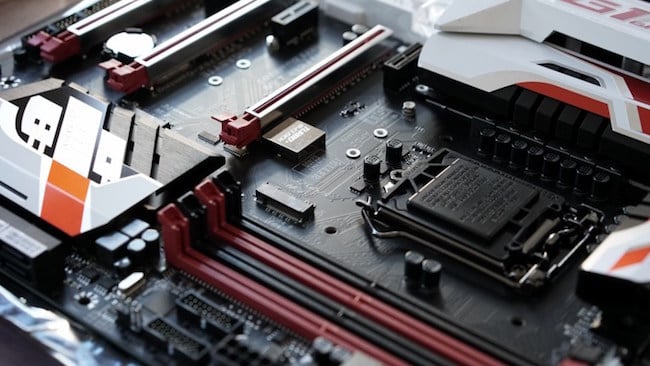
So what are we looking at above? That’s the motherboard ready to get stacked. The square that will hold your Skylake CPU is capped at first, but the metal latch swings open as you can see to the right. To get full speed out of your DDR4 DRAM memory, you have to install them in pairs (between those black-to-black, or red-to-red, or both, pairs of slots), and the DRAM sticks must have the exact same specs. I installed two pairs of 8gb sticks, totaling 32gb of DRAM, but you could install one pair for 16gb (still enough for a speedy system), or four pairs of 4gb each for 16gb.
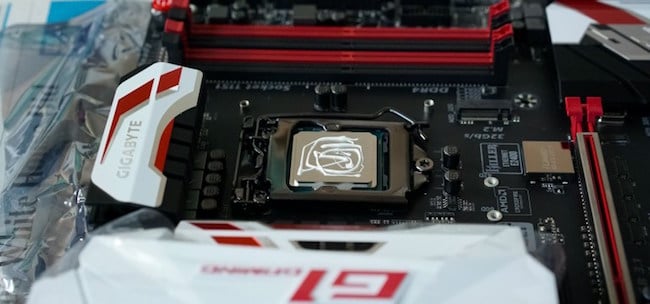
Before we get to that goo you see on the seated Skylake CPU above, look just to the right of it for that spot on the board (upside-down) that says M.2. That’s the newest and fastest possible way to run a boot drive (commonly called your “C:” drive). Even newer than mSATA (which was a notebook computer form factor for small SSDs), M.2 can tap into the motherboard’s PCIe x16 bus — those expansion slots with metal trim and clips on the end — for the fastest possible disk speeds you can achieve today (theoretically, 2GB/s). I installed an M.2 boot drive there that’s not quite the fastest, but this technology is growing fast, and soon we’ll see terabytes squeezed down to that tiny size. It’s the holy grail of fast, reliable media, as traditional magnetic hard drives become more and more antiquated. We’ll laugh someday about how our data got stored on spinning wheels with styluses bouncing back and forth to scribble data in and out. Can’t wait!
But back to the goo: that’s called thermal paste, and you need it to transfer heat from the burning hot metal surface of the CPU to a fan that bolts down on top of it, seen at left, blowing away the heat. You might have heard about “liquid cooling,” with futuristic tubes delivering refrigerant, but it’s really unnecessary. You’re not going to be overclocking into danger zones if you want a reliable creative platform. I just kept my old fan, and moved it onto this new CPU.
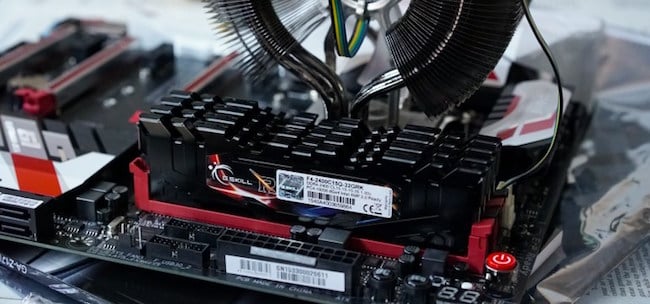
So we’ve got our CPU installed, got a relatively cheap fan bolted down to keep it cool, and the memory’s installed. That longest row of empty pin receptacles in the foreground above is the main spot where you get voltage/amperage from the power supply unit (PSU). Seen at bottom-right in the below picture, I chose a 600-watt model, which is the neighborhood of power that most systems of this type need. 1,000 watts is overkill, 500 watts is pushing it at the low end, and less than that is dangerous. It’s not critical to find a perfect number, but more is better, and PSUs are relatively cheap.
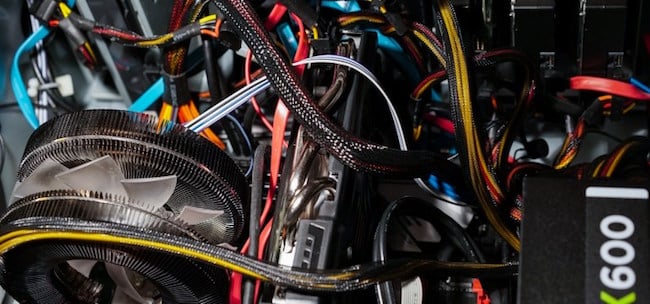
What about the case? As our computer comes together, you’re starting to see the biggest headache in system building: all those wires. Mainly, there are SATA cables (for the drives), USB/port cables, and power cables (usually braided, as you see below). Down the middle, the Nvidia GPU card is taking up lots of room, and it even needs its own power cable from the PSU, being a kind of a computer unto itself, with its own circuit boards and internal pair of cooling fans.
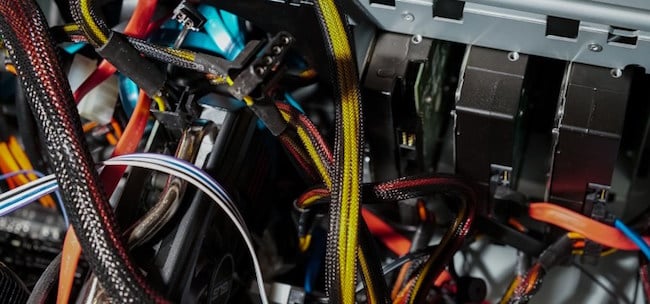
Around this whole mess, some folks spend lots of time on “cable management,” neatly bundling together related wires and even color-coding them, but I’m not so tidy. A good case should leave enough room to reduce confusion, but even more important is how the case holds your media storage drives in place (seen at top-right in the above photo), usually bracketed horizontally once you tip the case upright. You’ll be shifting them around a lot over time, whether you’re upgrading drives, or removing crashed ones. So, the measure of a good case is how easy it is to do that.
Case issues
Actually, the case you see here doesn’t do well, but I wanted to recycle it for this Skylake build instead of buying a new one and adding to the landfill. If you’re lucky enough to have a MicroCenter nearby, there’s nothing better than shopping for a case in-person; otherwise, you’ll be scrubbing the Interwebs for user reviews and placing an order for delivery. (I hear that Corsair’s Carbide series are among the best these days.)
Another key feature of a case is air flow. As seen in the picture at left, there is a rear fan and a top fan built into the case that help to circulate air, exhausting the heat from the CPU fan. By having more and larger (120mm) fans, your overall noise level goes down compared to the worse loudness of one small (90mm) fan or two needing to carry a heavy load, spinning madly beyond its means.
By now, everything’s hooked together, and in the picture at right you can see the rear panel with its numerous ports. From this angle, it’s healthy to equate the whole idea of external ports with the term “bottleneck,” especially when it comes to data storage. Internal drives directly connected to the motherboard via SATA3 (or especially that new M.2 bus) are faster than external drives connected via USB 3.0 or worse through those ports you see on the case, as a general premise. You could be booting internally from the fastest drive on the market, but: if you’re also editing video files stored on an external drive via USB, or even an internal 5400rpm “green” drive, everything slows down.
Of course, video files (especially these days, with high bitrates and Ultra-HD resolution) are the most demanding streams of data, and they deserve the fastest drives — not the slowest, which is ironically where many filmmakers store them in a sort of premature archival spirit. Similarly, you could get the fastest and biggest single drive on the market, responsible for all of your data instead of spreading tasks across multiple drives, and you’d have another type of bottleneck. Basically, you may have an extremely fast computer like this Skylake build, but it all means nothing if a single drive slows everything down.
So, what’s the plan?
1 Boot Disk (or “C:” Drive): small and fast SSD, for system and applications
2 Camera Footage Disk: large SSD, for video files, preferably removable (see Vantec example below)
3 Project Disk/Library: large SSD or 7200rpm hard drive (not 5400rpm), for project files and library
4 Cache Disk/Scratch Files: small SSD or 7200rpm (not 5400rpm) hard drive (can be combined with #3 if necessary), for, e.g., Adobe Media Cache and audio peak files
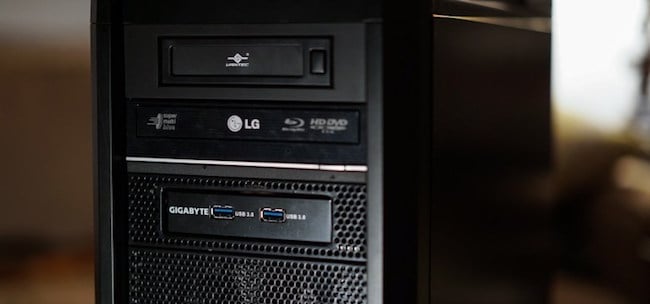
Those are just suggestions, but the theme is, you should spread out categories of use across multiple drives, and allocate drive speed to those tasks that need it most. Granted, we are on the brink of an all-SSD world, but they’re still expensive, and one versatile way to maximize their use is to put them into removable cartridges, for mobility and swapping projects. Above, the Vantec slot at the top of the enclosure’s face accepts a proprietary cartridge that not only connects straight into the motherboard’s native SATA3 6Gbit/s bus for maximum speed, but also has a reasonably fast USB 3.0 port for when you need to go mobile from a laptop. I am putting 1TB SSDs of camera footage into these cartridges, letting me swap between projects, and I take them with me to other workstations between studios, and on the road. It’s a clever solution that never quite caught on, but it’s still available, cheap, and highly recommended.
One last thing to mention is the inevitable fact that you’ve been accumulating a bunch of old hard drives over the years, replacing them with bigger and faster ones. You may not want them to be mounted and spinning inside your case, but for redundant archiving, an external enclosure can keep them useful. The Mediasonic 4-bay enclosure seen at left connects to your computer via either USB 3.0 or eSATA, and inside you can span multiple drives into single larger volumes using the “Storage Spaces” feature included in Windows 10. True, you wouldn’t want to rely on this feature for critical data (it’s just as dangerous as a Drobo), but it fits my archiving needs perfectly: I keep my camera footage and project files stored on drives inside my case, while also paying a small fee to CrashPlan for unlimited cloud storage of everything, which manages a parallel copy onto the external drives — so, I’m less worried about my external array, given the two other copies. This is a more pragmatic setup compared to redundant RAID arrays, which are thankfully nearing extinction (even though IT-department-types will probably stay stubborn). RAID was always a goofy compromise, invented partly for a speed boost that has since been eclipsed by the solid state disk.
Wrapping up
Wrapping up, for such a complex subject, this case study couldn’t have been a thorough step-by-step, how-to guide. But it’s meant to get you thinking about whether to build a system, and what would be involved. Upon flipping the power switch on, you’d need to buy a Windows license, and you’d have a world of overclocking waiting for you, to try and push Skylake to its limits.
Overclocking used to be only an enthusiast’s art form, but today it has become rather easy if not automatic: for example, stepping up processing power as a video render might demand it. Taking the broad view, this is a good time to upgrade, just when Intel has “tocked” into Skylake, and editing programs like Adobe Premiere have matured into accessing more DRAM, fully coding in 64-bit, and leveraging fast GPUs for more than just effects. Life is short: Don’t let your workstation slow you down!
Summary of recommended parts
Gigabyte GA-Z170X-GAMING7 Motherboard
Intel Skylake Core i7-6700K Central Processing Unit
G.SKILL Ripjaws 4 Series 32gb DDR4 SDRAM Memory
or: Bundle of Motherboard, CPU and Memory
Nvidia GeForce 900-Series Graphics Processing Unit Card
Corsair CX600 Bronze Certified Power Supply Unit
Corsair Carbide Series Computer Case
Samsung 950 Pro M.2 256gb PCI-Express 3.0 x4 Solid State Drive (Boot Disk)
Samsung 850 EVO 2TB Solid State Drive (Camera Footage Disk)
Vantec EZ Swap 2.5″ Drive Mobile Rack
Mediasonic 4-Bay External Drive Enclosure
This is a republished version of H. Paul Moon's original piece which you can read, along with many other excellent articles, here.
Tags: Technology


Comments